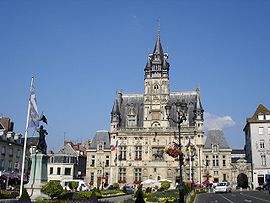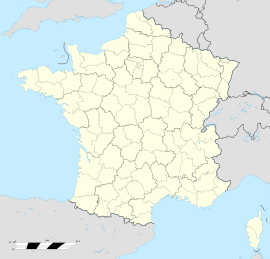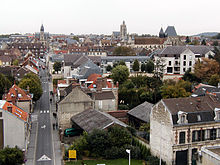- Compiègne
-
Compiègne

Town hall Administration Country France Region Picardy Department Oise Arrondissement Compiègne Intercommunality Région de Compiègne Statistics Elevation 31–134 m (102–440 ft)
(avg. 41 m/135 ft)Land area1 53.10 km2 (20.50 sq mi) Population2 41,714 (2007) - Density 786 /km2 (2,040 /sq mi) INSEE/Postal code 60159/ 60200 1 French Land Register data, which excludes lakes, ponds, glaciers > 1 km² (0.386 sq mi or 247 acres) and river estuaries. 2 Population without double counting: residents of multiple communes (e.g., students and military personnel) only counted once. Coordinates: 49°24′54″N 2°49′23″E / 49.4149°N 2.823056°E
Compiègne (French pronunciation: [kɔ̃pjɛɲ]) is a city in northern France. It is designated municipally as a commune within the département of Oise.
The city is located along the Oise River. Its inhabitants are called Compiégnois.
Contents
Administration
Compiègne is the seat of three cantons
- Compiègne-Nord (with 5 communes)
- Compiègne-Sud-Est (southeast) (with 4 communes)
- Compiègne-Sud-Ouest (southwest) (with 5 communes)
History
- 665 - Saint Wilfrid consecrated Bishop of York.
- February 888 - Odo, Count of Paris and king of the Franks was crowned in Compiègne.
- 23 May 1430 - During the Hundred Years' War, Joan of Arc was captured by the Burgundians while attempting to free Compiègne. They then sold her to the English.
- 1630 - Marie de' Medici's attempts to displace Richelieu ultimately led to her exile to Compiègne, from where she escaped to Brussels in 1631.
- 1900 - The golf events for the 1900 Summer Olympics took place.[1]
- 11 November 1918 - The Armistice with Germany (Compiègne), agreed at Le Francport near Compiègne, ends fighting of World War I
- 22 June 1940 - Another Armistice with France (Second Compiègne) was signed between Nazi Germany and the defeated France in Le Francport, near Compiègne, in the same place as in 1918, in the same railroad carriage, but with the seats swapped.
- 2004 - The Communauté de Communes de la Région de Compiègne becomes a partner in a European Union INTERREG IIIb project called SAND (see link below)
Historical population
- 1882: 13,393
- 1990: 41,663 (municipal), 44,703 (total)
- 1999: 41,076 (municipal), 44,703 (total), 69,903 (agglomeration), urban (108,234)
Sights
Museums
- Château de Compiègne - the castle itself, and museums of the Second French Empire, of historic figurines and of motoring and tourism within its walls
- Musée Antoine Vivenel
Compiègne Forest
Main article: Compiègne ForestThe Glade of the Armistice in the Compiègne Forest was the site of the signing of two armistices; the 1918 Armistice with Germany and the 1940 Armistice with France. Hitler specifically chose the location, and had the original signing carriage moved from Paris to Compiègne, as an irony for the defeated French. The site still houses several memorials to the 1918 armistice, including a copy of the original railway carriage. The original, after use in the 1940 armistice was moved to Berlin as a trophy of Nazi triumph. The railway carriage was later taken to Crawinkel in Thuringia in 1945, where it was destroyed by SS troops and the remains buried. A replica now stands at the original site.
Education
Compiègne is home to the University of Technology of Compiègne (UTC), an engineering school founded in the mid-1970s to provide an alternative to the traditional "grandes écoles" for students interested in technical fields. The UTC has a strong international students program known as Esperanto, and hosts students from around the world.
Transport
The Gare de Compiègne railway station offers connections with Paris, Amiens, Cambrai and several regional destinations. The nearest motorway is the A1 Paris-Lille.
Cycling
Since 1968 Compiègne is the traditional start city of the famous Paris–Roubaix bicycle race. It was also the finish city of 3rd stage in the 2007 Tour de France.
Notable people
Compiègne was the birthplace of:
- Roscellinus (~1050 - ~1122), philosopher and theologian, often regarded as the founder of Nominalism
- Pierre d'Ailly (1350–1420), theologian and cardinal of the Roman Catholic Church
- Albert Robida (1848–1926), illustrator, etcher, lithographer, caricaturist, and novelist
- Marcel Tabuteau (1887–1966), Oboist, regarded as the founder of American oboe playing.
- Suzanne Lenglen (1899–1938), tennis player, international female sport star
Twin towns
Compiègne is twinned with:
 Arona, Italy, since 1962
Arona, Italy, since 1962 Bury St Edmunds, England, since 1967
Bury St Edmunds, England, since 1967 Elbląg, Poland, since 2002
Elbląg, Poland, since 2002 Guimarães, Portugal, since 2006
Guimarães, Portugal, since 2006 Huy, Belgium, since 1959
Huy, Belgium, since 1959 Kiryat Tivon, Israel, since 1988
Kiryat Tivon, Israel, since 1988 Landshut, Germany, since 1962
Landshut, Germany, since 1962 Raleigh, North Carolina, United States, since 1989
Raleigh, North Carolina, United States, since 1989 Shirakawa, Fukushima, Japan, since 1988
Shirakawa, Fukushima, Japan, since 1988 Vianden, Luxembourg, since 1964
Vianden, Luxembourg, since 1964
Compiègne is also partnered with:
See also
- Communes of the Oise department
- Dialogues of the Carmelites
- Martyrs of Compiegne
- Monument aux morts (Oise)
- Siege of Compiègne
References
- ^ 1900 Summer Olympics official report. p. 15. Accessed 14 November 2010. (French)
External links
- City council website (in French)
- Le musée du château/The Château museum
- SAND Project site
- Steven Lehrer's Compiègne site
- INTERREG
- Universite de Technologie de Compiegne
- Joan of Arc Captured At Compiegne
- Cultural Association defending the Death-Rap values
- customized transport in compiègne
- Concerts in Compiègne
North: Clairoix, Choisy-au-Bac and Margny-lès-Compiègne West: Jaux, Venette Compiègne East: Saint-Jean-aux-Bois and Vieux-Moulin South: Lacroix-Saint-Ouen Venues of the 1900 Summer Olympics 7th arrondissement of Paris · Bois de Boulogne · Bois de Vincennes · Boulogne-Billancourt · Compiègne · Croix-Catelan Stadium · Le Havre · Meulan-en-Yvelines · Neuilly-sur-Seine · Puteaux · Satory · Seine · Tuileries Garden · Vélodrome de VincennesBaseball 1988 (demonstration): Jamsil Baseball Stadium • 1992: Camp Municipal de Beisbol de Viladecans, L'Hospitalet de Llobregat Baseball Stadium (final) • 1996: Atlanta-Fulton County Stadium • 2000: Blacktown Olympic Park, Sydney Baseball Stadium (final) • 2004: Olympic Baseball Centre • 2008: Wukesong Baseball FieldBasque pelota 1900: Neuilly-sur-Seine • 1992 (demonstration): Pavelló de la Vall d'HebronCricket Croquet Golf Jeu de paume Lacrosse Polo 1900: Bois de Boulogne • 1908: Hurlingham Club • 1920: Ostend • 1924: Bagatelle, Saint-Cloud • 1936: MayfieldRackets Rugby union 1900: Vélodrome de Vincennes • 1908: White City Stadium • 1920: Olympisch Stadion • 1924: Stade de Colombes • 2016 (sevens): São Januário StadiumSoftball 1996: Golden Park • 2000: Blacktown Olympic Park • 2004: Olympic Softball Stadium • 2008: Fengtai Softball FieldTug of war 1900: Bois de Boulogne • 1904: Francis Field • 1908: White City Stadium • 1912: Stockholm Olympic Stadium • 1920: Olympisch StadionWater motorsports Categories:- 1900 Summer Olympic venues
- Communes of Oise
- Subprefectures in France
- World Heritage Sites in France
Wikimedia Foundation. 2010.


